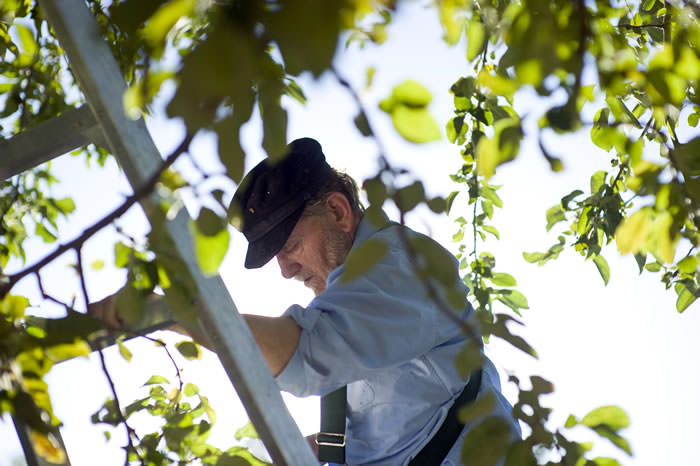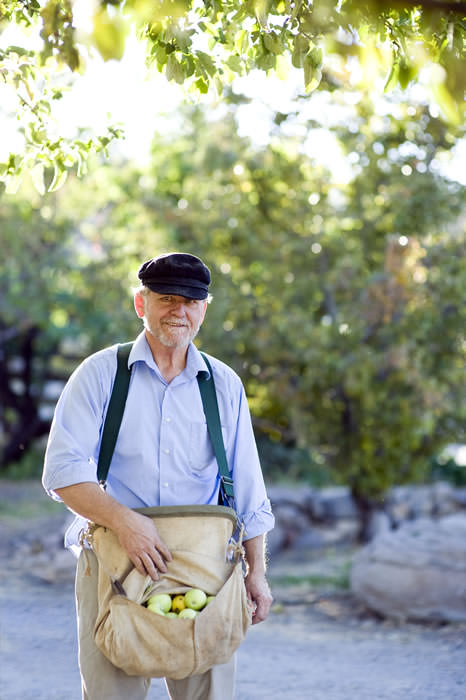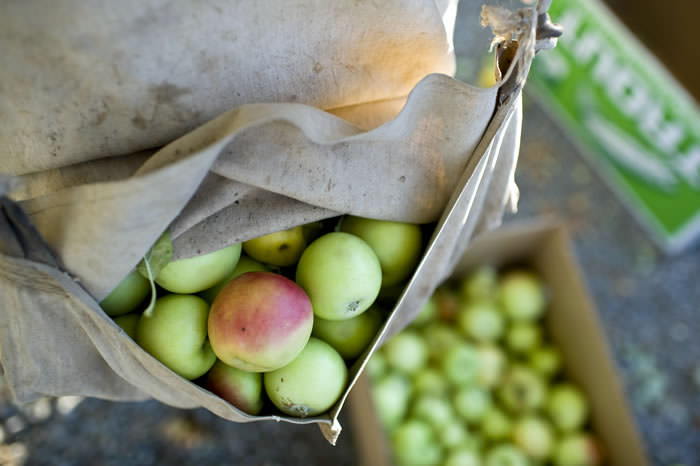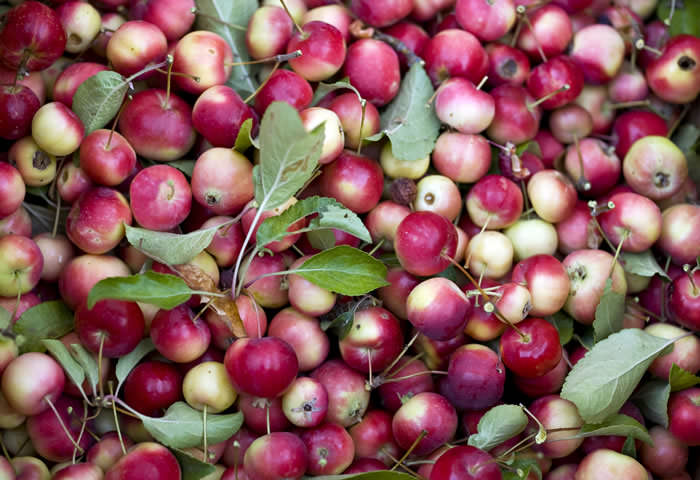meet the farmer
A TASTE OF HISTORY
Project restores local heritage apple groves.
WRITTEN BY KELSEY FITZGERALD
PHOTOS BY CANDICE NYANDO

Bill Murphy-Sharp is passionate about preserving a piece of Nevada’s history that can’t be kept in a museum: its heritage apple groves.
When early settlers set up homesteads and ranches around Genoa, Washoe Valley, and Reno during the mid- to late-1800s and early 1900s, many planted apple orchards on their properties. More than a century later, some of these original apple trees are still standing — and through the efforts of the Community Horticulture and Cider Making project, Murphy-Sharp and a team of arborists, landowners, and volunteers are working to locate, protect, and restore the aging trees to good health and production.
Murphy-Sharp, who is the founder and project manager for CHCM, also directs a program for the School of Medicine at the University of Nevada, Reno, and lives and grows fruit and other produce at Tea House Gardens, a farm in Washoe Valley.
His interest in heritage apples began in 2004, while he and his wife, Donna, lived as tenants at Belli Ranch, a historic ranch near Mogul, Nev., south of the Truckee River. The trees were badly in need of care and maintenance and had not been pruned in a decade. Murphy-Sharp realized that trees on other historic properties in the region were likely facing a similar fate.
“It just kind of dawned on me one day that these trees are not going to make it because people are not able to take care of them,” Murphy-Sharp says. “They don’t know how to do it.”

A call to action
Historic groves of apple trees are important to preserve because the trees are time-tested to do well in the region where they are planted, and they may be unique varieties or varieties that are no longer commercially available. In 2014, Murphy-Sharp applied for funding from the Nevada Department of Agriculture and received a specialty crop block grant to identify and restore local heritage apple groves, which the project loosely defines as groves of trees older than 75 years of age.
With this funding, Murphy-Sharp formed the CHCM. He and his team located several sites in the region with heritage trees that were in need of care. Many were overgrown, and the quality of fruit had declined over the years due to pests and lack of upkeep. For the 2017 season, the team has been working with trees on three historic sites in Washoe Valley — about 40 trees in all.
“When the apples get worms in them from codling moths, the worms change the flavor,” Murphy-Sharp says. “And when you don’t thin the fruit, then the fruit doesn’t get to full size.”
An important part of CHCM’s mission is to educate local people on how to care for and harvest fruit from these trees. To help with this, Murphy-Sharp recruited Michael Janik, a retired arborist with his own Reno orchard, Michael’s Apples, to train the CHCM crew in proper tree-care techniques.
“Basically, what CHCM has been doing is going in, checking the trees, cutting off excess limbs, opening them up to sunlight, and then making sure they’re getting water, which has been a problem when they’re just left out there,” Janik says. “Also, controlling for pests.”

Fruits of their labor
The results of CHCM’s efforts? Happier trees, with lots of fruit. In 2016, the group harvested more than 3,200 pounds of fruit from 29 of the trees enrolled in the project, Murphy-Sharp says. Of those, tree owners received 985 pounds; the CHCM project received 2,542 pounds of apples.
At the end of each harvest season, team members hold a community cider-making event, at which the public is welcome. Most of the apples that came to CHCM in 2016 went into the cider (the rest were sold through Tea House Gardens to help support the project). Murphy-Sharp, who credits his grandfather, a farmer from Iowa, with instilling in him an appreciation for cider, says that juice made from the trees in Nevada’s heritage apple groves is exceptionally delicious.
“The flavor is just amazing,” Murphy-Sharp says, “in part because it’s so fresh. It has not been filtered. And in part because these trees have some sugars and tannins and characteristics that a lot of today’s commercial ones don’t, because they’re being grown to be crispy and keep in the refrigerator. Not so with these; these were kept because they had their own integrity.”
Kelsey Fitzgerald is a freelance writer in Reno. She grew up in Ithaca, N.Y., where she used to enjoy visiting the famous Cornell Orchards and tasting their many varieties of apples and ciders.
Resources
For details on the Community Horticulture and Cider Making project, visit Nnvappleproject.wixsite.com/chcm.
For CHCM arborist Michael Janik’s schedule of tips on how to care for apple trees throughout the year, visit Michaelsapples.com/apple-calendar.
Recipe
Mom’s Apple Pie
(courtesy of Michael Janik, owner, Michael’s Apples in Reno. Serves 6 to 8)
Though he really prefers to eat apples out of hand for a snack or dessert, just as they are (not to mention in cider), he likes this apple pie recipe from his mom, which also is found on his website, Michaelsapples.com/recipes.
Pie crust dough (Janik uses store bought: “I’m a cook, not a baker.”)
8 to 10 medium-sized, tart apples
½ cup sugar
Dash of cinnamon
Handful of chopped pecans
½ stick (or 4 ounces) butter
½ cup brown sugar
½ cup flour
Preheat oven to 350 degrees F. Fill pie pan with dough.
Grate apples into bowl using ¼-inch side of grater. Add sugar, cinnamon, and pecans. Mix well, then put filling into dough-lined pie pan.
Make topping: Put butter in mixing bowl. Cut brown sugar into butter and mix until smooth. Add flour slowly and mix until lumps are smaller than 1 inch. Crumble topping over pie, spreading evenly.
Bake pie for 50 to 60 minutes, until crust and topping are brown. Set aside to cool — no tasting until after dinner!
For a low-carb version (sans crust), Janik lightly butters a 9-by-11-inch, rectangular baking dish, fills it with a mound of sliced apples, and doubles the topping recipe (i.e. Mix 1 stick butter, 1 cup brown sugar, and 1 cup flour; cover and bake at 350 degrees F for about 1 hour).
For a great, quick main dish: Sauté onion and apple slices in butter until golden, then add previously grilled, leftover chorizo or sausage.


